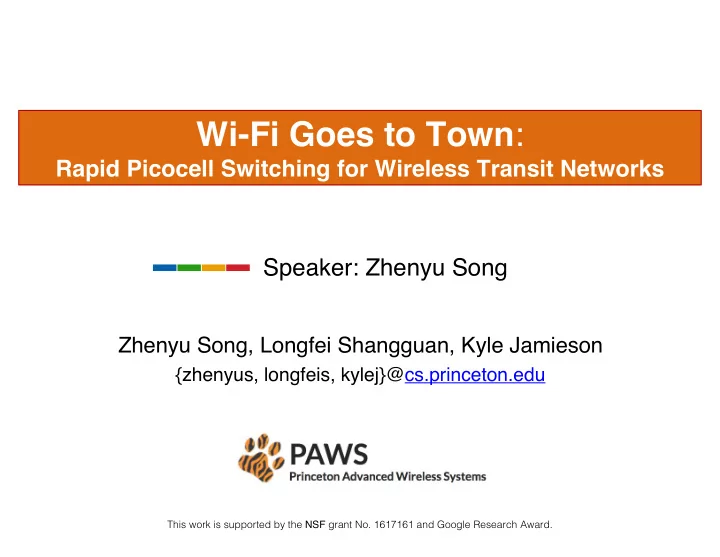

Wi-Fi Goes to Town : Rapid Picocell Switching for Wireless Transit Networks Speaker: Zhenyu Song Zhenyu Song, Longfei Shangguan, Kyle Jamieson {zhenyus, longfeis, kylej}@cs.princeton.edu This work is supported by the NSF grant No. 1617161 and Google Research Award.
Motivation � Billions of commuters on trains, light rails and in cars surf the internet Conference How can we increase the wireless network 1000X in bits/(second*dollar)? Online Video VR gaming 2
Motivation � “ The majority of capacity gains over the past 45 years is due to the decreased size of each cell.” ——Cooper AP AP 3 AP 4 AP 1 AP 2 increasing capacity gain 3
Two recent observations � Very low-cost AP (<= $5) The ESP8266 Wi-Fi and system-on-chip module,available ca.2016 for $5. � Commodity APs can extract fine-grained channel state information [Halperin et al .] 4
Wi-Fi Goes to Town: Picocell AP network for transit AP AP AP AP AP AP AP AP AP AP AP AP AP 5
Problem: picocells + vehicular speed � How to support switching between APs? AP AP AP AP AP AP AP AP AP AP AP AP AP APAP AP AP AP AP We need to switch fast! 6
Problem: rapid multi-path fading � Rapid ( ms -scale) channel fading due to the multi-path AP 1 AP 2 AP 3 AP 1 AP 2 Channel Capacity AP 3 1 2 1 2 Time (ms) We need to switch at a millisecond level! Best AP sequence is not left-to-right order 7
Design � Who maintains states and makes switching decision � When to switch (to which AP) � How to switch 8
Design � Wi-Fi Goes to Town: system architecture 9
Design::who A controller maintains states and makes decisions 10
Design::when (and which) � AP selection algorithm Controller maintains an Effective SNR value window (10 ms), and selects AP with largest median value . AP1 19 17 13 12 10 AP2 13 14 17 13 19 14 13 15 18 AP3 Time window window window AP 3 AP 1 AP 2 11
Design::how � Association � Uplink (from client to AP) � Downlink (from AP to client) 12
Design::how � Wi-Fi Goes to Town: AP-client association All APs associate with client propagate info extract hostapd AP 1 AP 1 client info AP 3 AP 2 hostapd AP 2 send to hostapd AP 3 13
Design::how � Wi-Fi Goes to Town: Uplink flow Stripe and de-duplicate same bssid AP 1 AP 2 AP 3 tunneling 14
Design::how � Wi-Fi Goes to Town: Downlink flow 3 3 3 2 2 2 ack 1 1 1 start AP 3 AP 2 AP 1 15
Design::how � Wi-Fi Goes to Town: Downlink packet synchronization tunneling set as 80211 seq AP 2 AP 1 16
Introduction of aggregation in 802.11n MPDU aggregate frame 1,2,3 block ack partial ack 1 3 4 2 frame 1 sender window sender window MPDU aggregate frame 2,3,4 Sender Receiver 17
Problem: block ack lost causes mac layer inefficiency AP 1 AP 2 AP1 needlessly retransmits whole aggregate 18
Solution: block ack forwarding AP 1 (associated) kernel 3 2 block ack 1 AP 2 (adjacent) AP 1 AP 2 AP 3 kernel 19
Implementation � Wi-Fi Goes to Town: Two Deployment Schemes 20
Implementation: hardware AP : TP-Link N750 AP, Larid directional antenna, Atheros CSI Tool [Xie et al .] Controller : Lenovo Thinkpad T430 21
Evaluation: questions � How much does Wi-Fi goes to town improve uplink reception rate? � Does Wi-Fi goes to town increase jitter? � Does Wi-Fi goes to town achieve higher end-to-end throughput? 22
Short demo AP Downlink packet retrans packet Uplink packet 23
Strawman: 802.11r (enhanced) � (Original 802.11r) Fast handover: � Fast BSS transition. � Client maintains time-averaged RSSI, and switch when below threshold � (Enhanced ) Fast nearby AP discovery: � Each AP tells client nearby AP information � Client overhears beacons 24
Wi-Fi goes to town achieve lower uplink loss rate by over-hearing Uplink loss rate 25
Wi-Fi goes to town achieves seamless switching at speed � TCP Download RSSI ↓ , switch! (Too late) 26
Wi-Fi goes to town achieves seamless switching at speed � TCP Download 27
Wi-Fi goes to town achieves seamless switching at speed � TCP Download ms-scale switching 28
Wi-Fi goes to town achieves higher end-to-end throughput � Single-client, download 802.11r’s performance degrades with speed while Wi-Fi goes to town not 29
Wi-Fi goes to town achieves higher end-to-end throughput � Multi-client Average Throughput (Mbit/s) Wi-Fi goes to town always achieves higher performance 30
Conclusion � First roadside hotspot network at vehicular speeds with meter-sized picocells. � Execute switch decisions at millisecond-level granularities. � First step in a line of work that will scale out the wireless capacity of roadside hotspot networks using small cells. 31
Questions? zhenyus@cs.princeton.edu � ���������� 32
Recommend
More recommend